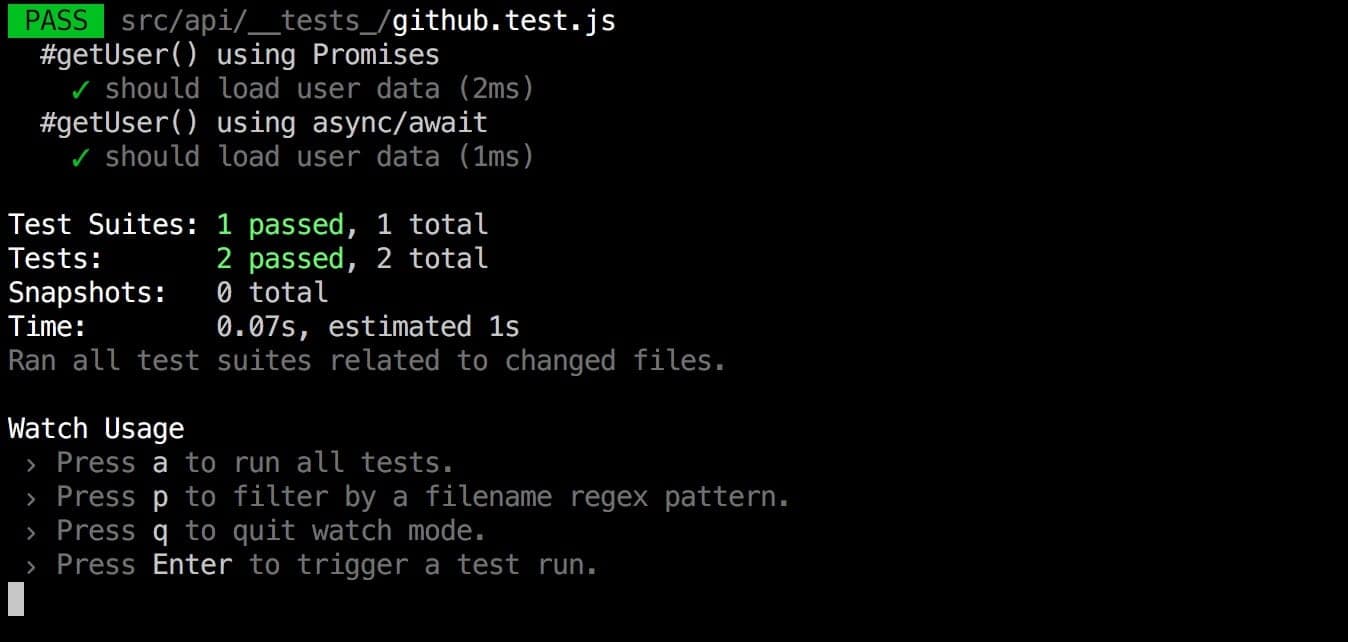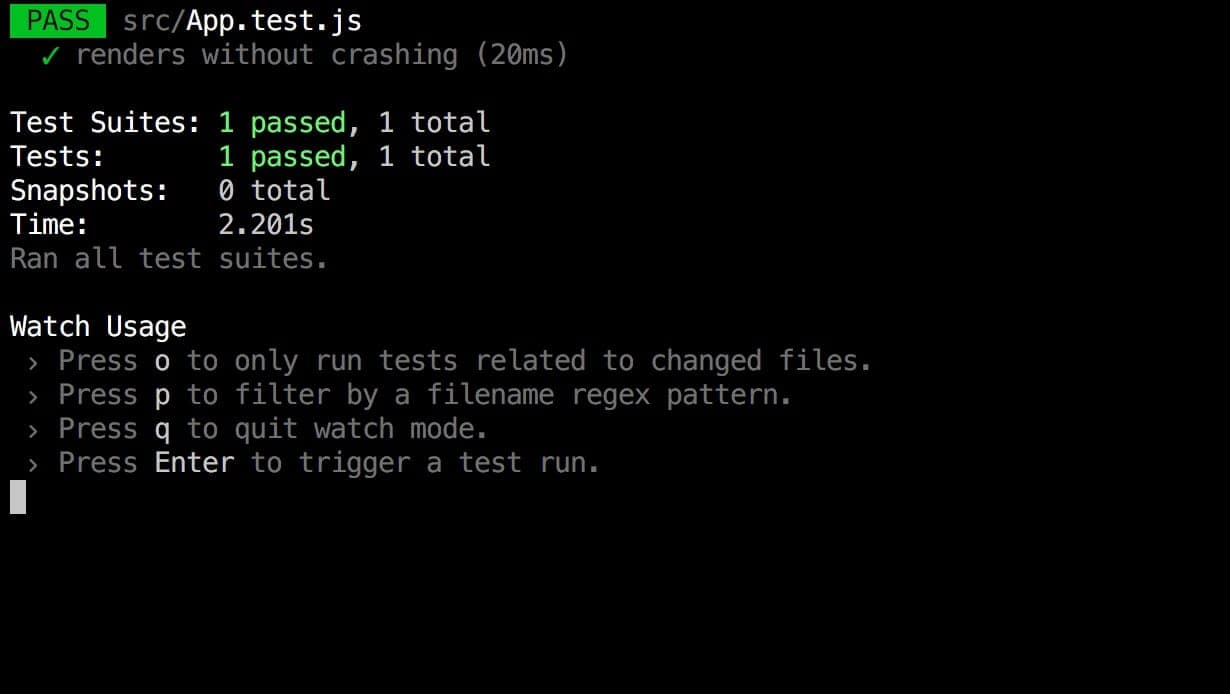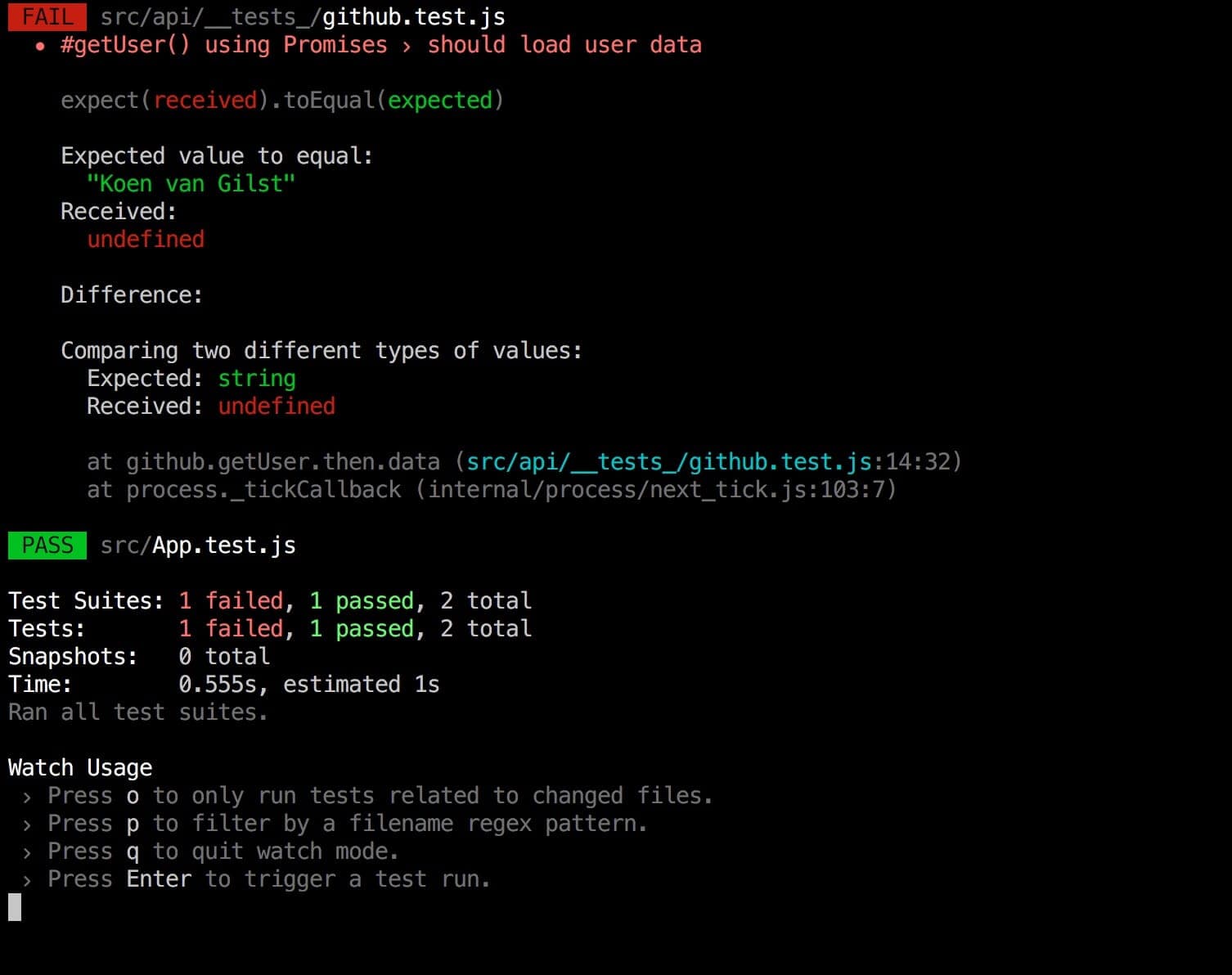API testing with Jest
February 6, 2017
6 min read

This article was written in 2017 and today there are much better ways to mock API calls in Jest. I would recommend looking into a library called Mock Service Worker to mock API calls.
Jest is a great JavaScript testing framework by Facebook. It’s often used for testing React components, but it’s also a pretty good general-purpose testing framework. In this tutorial, I’ll give a quick and simple demo of its mocking capabilities for testing async functions.
Purpose of mocking
Mocking async functions (like API calls) instead of testing with a real API is useful for a couple of reasons:
- It’s faster: you don’t have to wait until the API response comes in and you don’t have to deal with rate limits.
- It makes your tests
pure, i.e. whether they fail or pass depends only on your code, and not on the data that the API returns. - It’s easier in the long run: no need to first login or set some state before you can start testing a certain endpoint.
Setting up Jest
Configuring Jest isn’t all that difficult, but to get started quickly I’m using the official starter kit by Facebook, create-react-app. This comes with a working Jest configuration out of the box!
Install the create-react-app and create the app:
yarn global add create-react-app
create-react-app mocking-with-jest
cd mocking-with-jest/
yarn start
This should open a browser window with a spinning React logo.
Now start the Jest testing environment:
yarn test
You should see something like this:

Congratulations, you’ve now got Jest up and running and are ready to start writing some tests!
Adding the API
We’ll be using rest.js for making the API requests. Rest.js works well in the browser and Node.js.
Note (2018): Rest is no longer actively maintained. Use something like isomorphic-fetch instead.
yarn add rest
Create a new folder api in the folder src and add the file github.js with the following code:
import request from './request';
const getUser = (user) => request(`https://api.github.com/users/${user}`);
export { getUser };
Then also add request.js with the following code:
const rest = require('rest');
const mime = require('rest/interceptor/mime');
export default rest.wrap(mime);
You’re now ready to make API requests using: github.getUser(‘vnglst’). Let’s test this quickly in the browser. Replace the original contents in the file App.js with the following code:
import React, { Component } from 'react';
import './App.css';
import { getUser } from './api/github';
const renderLine = (user, key) => (
<li key={key}>
<b>{key}</b>: {user[key]}
</li>
);
class App extends Component {
constructor(props) {
super(props);
this.state = { user: {} };
}
componentDidMount() {
getUser('vnglst').then((data) => {
this.setState({ user: data.entity });
});
}
render() {
const { user } = this.state;
return (
<div className="App">
<ul style={{ listStyle: 'none' }}>
{
// Loop over the object keys and render each key
Object.keys(user).map((key) => renderLine(user, key))
}
</ul>
</div>
);
}
}
export default App;
Use yarn start to open up a browser and see the result. You should see a simple list with my profile data. It works!
Writing tests
We’re now ready to write some tests. Let’s first try to unit test the function getUser. Create a folder __tests__ and in this folder a file github.test.js with the following code:
/* eslint-env jest */
const github = require('../github');
// A simple example test
describe('#getUser() using Promises', () => {
it('should load user data', () => {
return github.getUser('vnglst').then((data) => {
expect(data).toBeDefined();
expect(data.entity.name).toEqual('Koen van Gilst');
});
});
});
Start Jest using yarn test and you should see the following error message:

What’s happening here? It turns out that using our getUser function in a Node environment (which Jest is using to run the tests) makes our request fail. So even though our function works in the browser, it fails in our tests! We could try and fix this, by adding a User-Agent header when we’re running this in a Node environment, but mocking would now be a better solution. Let’s set this up!
Creating a mock
Create a folder __mocks__ and in this folder a file request.js (this will be the mocked version of request.js in the parent folder):
const fs = require('fs');
const request = (url) =>
new Promise((resolve, reject) => {
// Get userID from supplied url string
const lastSlash = url.lastIndexOf('/');
const userID = url.substring(lastSlash + 1);
// Load user json data from a file in de subfolder for mock data
fs.readFile(
`./src/api/__mockData__/${userID}.json`,
'utf8',
(err, data) => {
if (err) reject(err);
// Parse the data as JSON and put in the key entity (just like the request library does)
resolve({ entity: JSON.parse(data) });
}
);
});
export default request;
The mocked function expects a userId.json (i.e. vnglst.json) file in a folder mockData. I’ve used my own Github username and data as an example here, but you can add as many example data as you need for your tests:
{
"login": "vnglst",
"id": 3457693,
"avatar_url": "https://avatars.githubusercontent.com/u/3457693?v=3",
"gravatar_id": "",
"url": "https://api.github.com/users/vnglst",
"html_url": "https://github.com/vnglst",
"followers_url": "https://api.github.com/users/vnglst/followers",
"following_url": "https://api.github.com/users/vnglst/following{/other_user}",
"gists_url": "https://api.github.com/users/vnglst/gists{/gist_id}",
"starred_url": "https://api.github.com/users/vnglst/starred{/owner}{/repo}",
"subscriptions_url": "https://api.github.com/users/vnglst/subscriptions",
"organizations_url": "https://api.github.com/users/vnglst/orgs",
"repos_url": "https://api.github.com/users/vnglst/repos",
"events_url": "https://api.github.com/users/vnglst/events{/privacy}",
"received_events_url": "https://api.github.com/users/vnglst/received_events",
"type": "User",
"site_admin": false,
"name": "Koen van Gilst",
"company": null,
"blog": "www.koenvangilst.nl",
"location": "Utrecht, The Netherlands",
"email": "koen@koenvangilst.nl",
"hireable": true,
"bio": "Web Developer & Translator | JavaScript, Node, Express, React | Creator of @TermSearch ",
"public_repos": 45,
"public_gists": 17,
"followers": 21,
"following": 75,
"created_at": "2013-02-02T16:06:27Z",
"updated_at": "2017-02-04T14:24:18Z"
}
To let Jest mock the request module, you have to add the following line to github.test.js file:
jest.mock(‘../request’)
Now the simple unit test should pass and you’re ready to write more complicated tests!
I hope you enjoyed this tutorial and feel free to ask me any questions. You can find me on Twitter as @vnglst. The source code of this tutorial can be found here
This tutorial is based upon the async example by the creators of Jest (and their example is probably better 😂). Be sure to also check out their other examples.
BONUS: testing using async/await
If you’re using the create-react-app you can also use async/await to write your tests. This makes your tests easier to write and more readable:
// The exact same test using async/await
describe('#getUser() using async/await', () => {
it('should load user data', async () => {
const data = await github.getUser('vnglst');
expect(data).toBeDefined();
expect(data.entity.name).toEqual('Koen van Gilst');
});
});